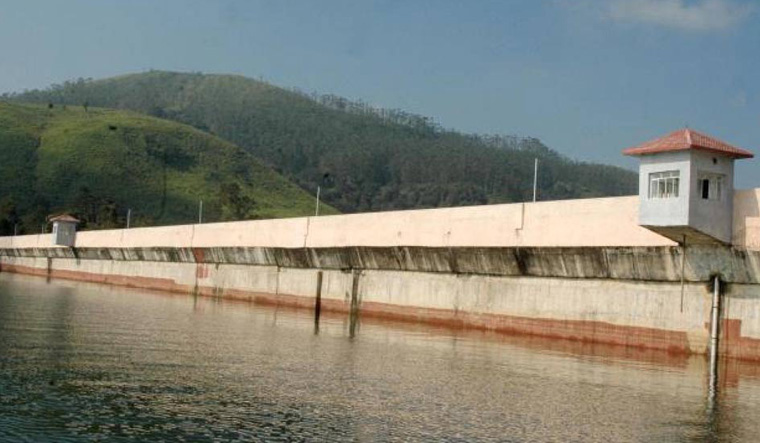The Kerala government has told the Supreme Court that a larger bench should review the 2014 verdict of the top court comprehensively by which it had allowed water level in the 126-year-old Mullaperyiar dam to reach 142 feet.
The state government filed its written submission in the pending matter and said that the only permanent solution for removing the eternal threat of damage to the dam is to build a new dam in the downstream reaches of the existing Mullaperiyar dam.
In 1979, a team of engineers from both States (Tamil Nadu and Kerala) headed by the then Chairman of the Central Water Commission had made a specific recommendation for constructing a new dam as a permanent solution to the safety problem of the existing dam. The Empowered Committee in their report under the title Way Forward towards an Amicable Resolution has dealt with this aspect as the first alternative and this Court has endorsed the same in its judgement dated May 7, 2014, the state government said.
The state government further said that the Ministry of Environment and Forest granted terms of reference (TOR) for the Environment Impact Assessment (EIA) study of a New Mullaperiyar dam on November 14, 2018, along with conditions for the preparation of the EIA/EMP Report.
The apex court is seized of pleas raising issues about the safety of the dam, which was built in 1895 on the Periyar river in the Idukki district of Kerala.
In the above circumstances it is necessary that the judgment of 2014 be now comprehensively reviewed, if necessary, by a larger bench of this Court, the state government said, adding that the well-settled principles of environmental law like the precautionary principle discussed by this Court in 2005 verdict must be taken into consideration in reviewing the said judgment.
It submitted that Kerala has witnessed excessive and erratic rainfall and disastrous floods during the monsoon season of four consecutive years from 2018-to 2021 particularly in the Idukki district where the Mullaperiyar dam is situated.
It is now accepted that the world over the climatic conditions are changing. In 2021, the State of Uttarakhand faced a dam disaster known as the Chamoli disaster at the Tapovan dam site. In these times of environmental change, no amount of rejuvenation can perpetuate a 126-year-old deteriorated dam that now exists at Mullaperiyar. Merely carrying out strengthening measures would not be sufficient, it said.
It said that in compliance with the judgment of this Court dated May 7, 2014, a three Member Supervisory Committee was constituted consisting of the Chief Engineer, Dam Safety Organisation of the Central Water Commission (Chairman), Principal Secretary, Public Works Department of Government of Tamil Nadu and Additional Chief Secretary, Water Resources Department, Government of Kerala and so far 14 meetings of the supervisory committee has been held.
The state government said, In the present composition of the Supervisory Committee, except for the Chairman, the other two Members are in the rank of Administrative Officers. It is imperative that two independent Technical Experts having expertise in dam management should be included as members in the Supervisory Committee and the Committee should be reconstituted accordingly.
It sought direction that the Supervisory Committee to carry out its function should set up a permanent office at Kumily near the dam site which shall function on a day-to-day basis with sufficient engineers and technical staff to monitor the safety and safe operation of the dam.
It shall independently collect seepage data, instrumentation data, geodetic survey data, and all such data with respect to the dam. It shall conduct meeting regularly every fortnight as is done by the Cauvery Water Regulation Committee for the approval of the data by the party States, it said, adding that the committee shall also conduct a physical inspection of the dam periodically.
It is submitted that, as will be evident from facts stated in, particularly at the end of the monsoon season when the water level in the reservoir is at its highest, namely at 142 feet, further rainfall has resulted in the erratic release of the heavy volume of water without sufficient forewarning at night thereby creating heavy damage to the people and their property, who are living in the downstream of the Mullaperiyar Dam, it added.
The state government said that therefore, it is necessary for this Court to provide that the gate operation schedule should not result in the release of huge quantities of water at night.
On February 3, the Tamil Nadu government has told the top court that it is not justifiable to have a fresh review on the safety of the 126-year-old Mullaperiyar dam before carrying out the strengthening measures ordered by the apex court earlier.
The state government made the averment in its response to the status report filed on January 27 by the Central Water Commission (CWC) and the supervisory committee which had said that a fresh review of the safety of the dam is now due and is required to be undertaken.
On January 11, the apex court had said that litigation about the dam is not adversarial as this is public interest litigation in the sense that safety, security, and health issues of the people staying around the dam are involved in the matter.





